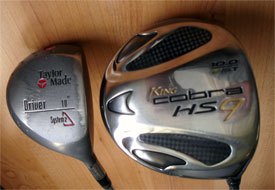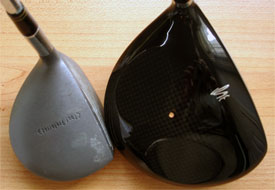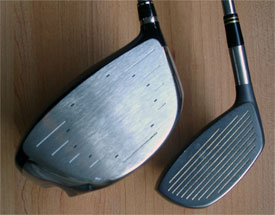Metal Wood
by Andrew Boyd
Today, metal wood. The University of Houston's College of Engineering presents this series about the machines that make our civilization run, and the people whose ingenuity created them.
Spoon. Mashie. Jigger. Niblick. They're not kitchen utensils. They're the names of early golf clubs.
 But whatever we call them, there's one very special club in every player's bag — the driver. Golf is a game of power and finesse — of knocking a tiny ball hundreds of yards, then precisely tapping it a few feet into a hole that's just over four inches wide. But most golf enthusiasts will tell you the fun's in the power. And that's what the driver's designed for.
But whatever we call them, there's one very special club in every player's bag — the driver. Golf is a game of power and finesse — of knocking a tiny ball hundreds of yards, then precisely tapping it a few feet into a hole that's just over four inches wide. But most golf enthusiasts will tell you the fun's in the power. And that's what the driver's designed for.
There are three main categories of golf club recognized by the U.S. Golf Association: putters, irons, and woods. The driver is a wood. And it's designed to hit the golf ball farther than any other club. Irons and woods take their names from the materials used to make them in the early twentieth century.
For decades, the wood of choice for making a driver was persimmon. That changed in 1979 when the TaylorMade golf company began making drivers and other woods out of metal, giving rise to one of the great oxymorons of all time, the metal wood. Two years after their introduction, the first professional golf tournament was won with a metal wood — the Houston Open. It was the first step on a road that would see the wooden wood disappear.
Technological improvements have been phenomenal since metal woods were first manufactured. Drivers, and all golf clubs, are now engineered with the same attention given to jet aircraft. And they use the same materials. Titanium. Carbon composites. Engineers have pushed design limits to the point where golf's governing bodies are pushing back.
Technology has the potential to substantially change the games we play. For the U.S. Golf Association, the two biggest concerns are size and springiness. Springiness didn't used to be an issue. After all, wood was wood. But metal can be engineered to give the golf ball a little extra kick. That kick is now limited by the rules of golf.
Metal can also be used to make larger club heads without them becoming too heavy. The bigger the club head, the easier it is to hit. Today's metal drivers are over three times the size of their early counterparts. They're so big they're almost comical. And in 2002, it looked like there was no end in sight. So the U.S. Golf Association placed a limit on club head size to "protect tradition." Golf club makers were not happy. It stymied innovation — and profits. But the furor soon subsided.
There's still no agreement what to call metal woods. Some people continue to call them woods; others call them metals. But whatever the name, they've come a long way from the baffies and brassies of yore.



I'm Andy Boyd at the University of Houston, where we're interested in the way inventive minds work.
For a related episode, see 1716, Bounding Billies.